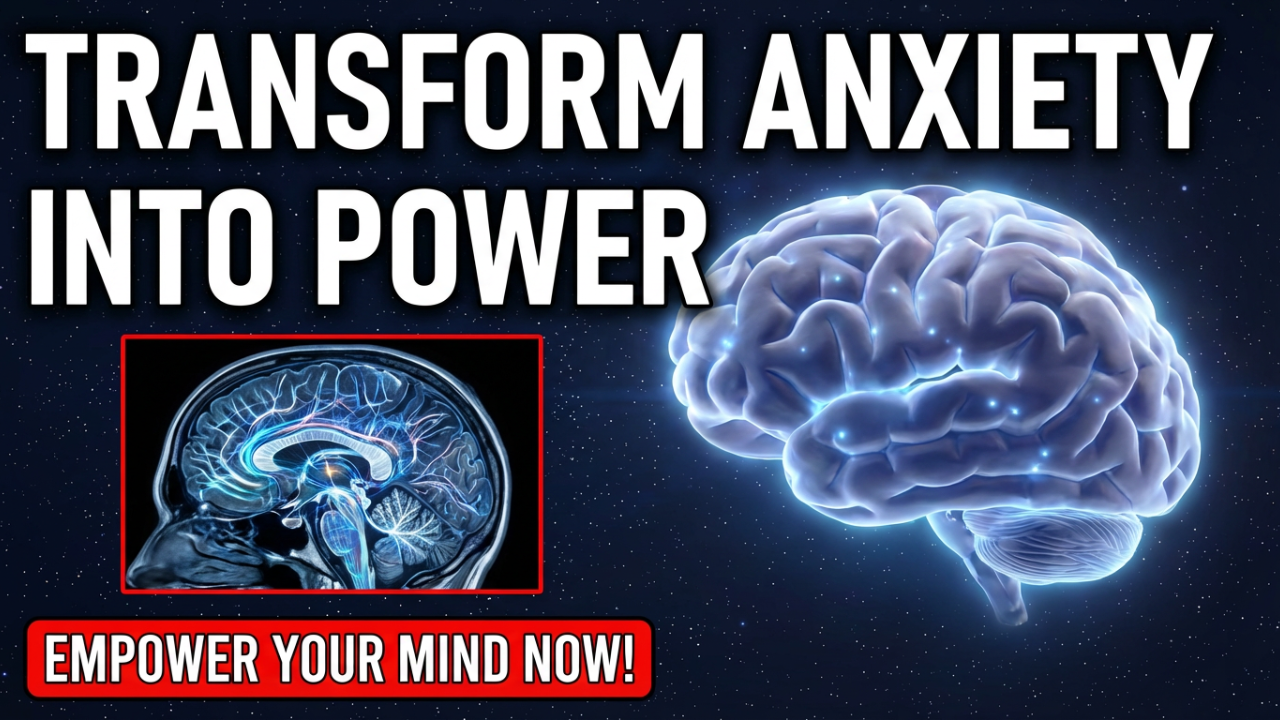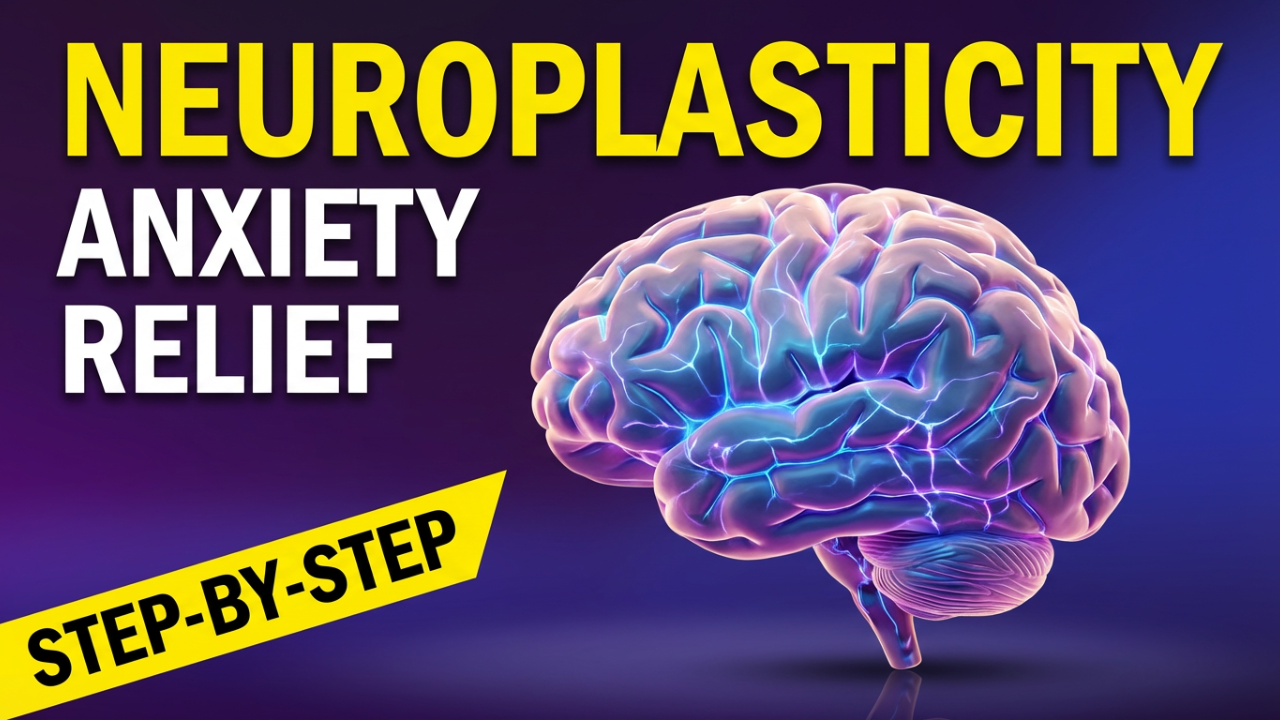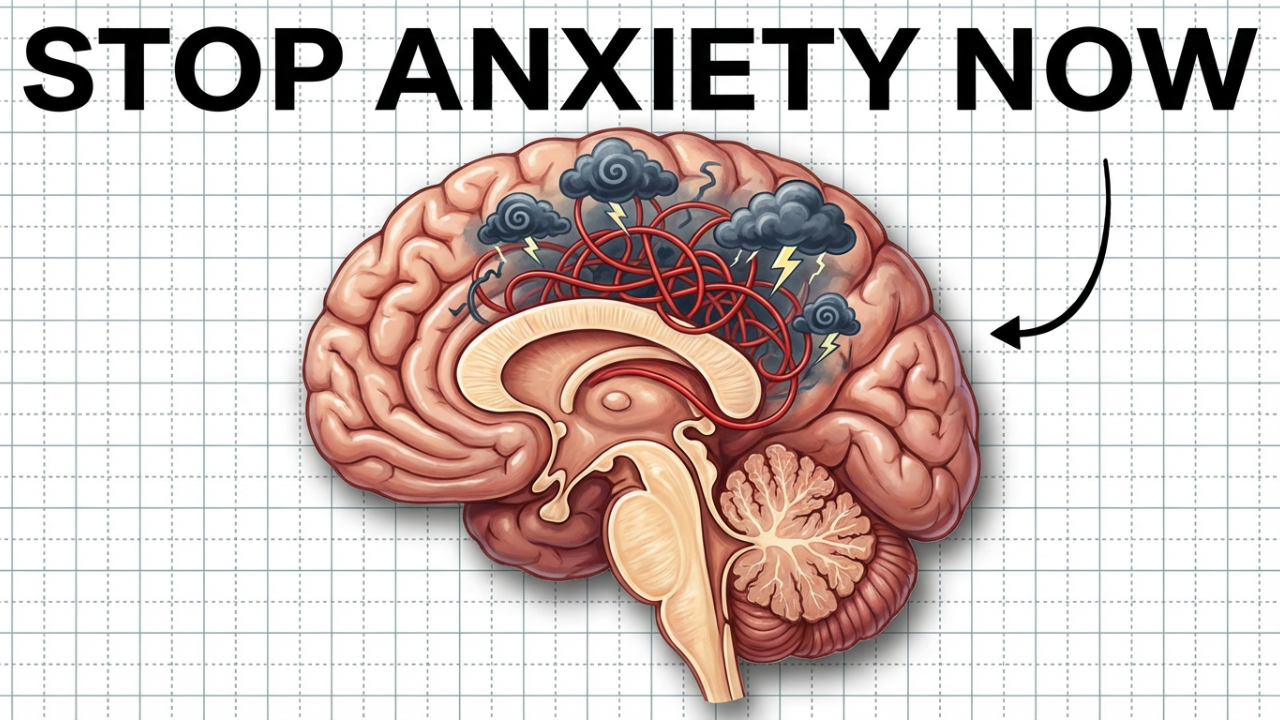What if the key to breaking free from anxiety wasn’t somewhere out there in the world, but right inside your own mind? For years, we’ve been told to fight anxiety, to distract ourselves from it, to manage it. But what if we could *rewire* it? What if the very source of our most terrifying thoughts could become our most powerful tool for healing?
This isn’t just wishful thinking. This is neuroscience. In this video, we’ll unveil how simple imagination exercises can re-route your brain’s fear circuits and build new pathways to lasting calm. You’re about to learn how to use your mind not just to cope with anxiety, but to change its grip on you at a neurological level. You have more power over your anxious brain than you’ve ever been led to believe, and by the end of this video, you’ll know exactly how to use it.
This book is scientific documentary of the Kingdom of God.
**(Section 1: The Anxiety Trap – The Problem)**
Before we can dismantle the trap, we have to understand how it’s built. Have you ever been caught in an anxiety spiral? It starts with a single, innocent-seeming thought. Maybe it’s a vague email from your boss that just says, “We need to talk.” And immediately, there’s that jolt. Your heart beats a little faster. Your palms get clammy. That’s your body’s ancient survival system kicking in.
But then, the thought escalates. “What did I do wrong? Am I getting fired? How will I pay my rent?” This flood of catastrophic thoughts isn’t just happening in your head; it’s fueling a physical fire. The faster your heart beats, the more your mind screams that there’s a real, present danger. And that’s the anxiety cycle. It’s a vicious feedback loop where an anxious thought triggers a physical fear response, and that physical fear response proves to your brain that the initial thought must have been true. You feel scared *because* you think you’re in danger, and you think you’re in danger *because* you feel scared.
You feel stuck because, in a very real way, you are. Your brain has learned this pattern. Through repetition, it’s carved out a deep neural pathway—a superhighway for fear. Every time you complete that loop, you reinforce it, making the road wider, faster, and more automatic. It’s like a song stuck on repeat, and the volume just keeps getting louder.
This isn’t a character flaw or a sign of weakness. It’s a biological process that has gone into overdrive. The part of your brain responsible for this is trying to protect you, but its alarm system has become way too sensitive. It’s like a smoke detector that goes off every time you make toast. The intention is good—keep you safe from fire—but the execution is exhausting, overwhelming, and makes it impossible to just live your life.
The experience of being trapped in this cycle is profoundly disempowering. You start to fear the feeling of anxiety itself. You might start avoiding situations that could trigger it—social gatherings, work presentations, maybe even leaving the house. Your world starts to shrink. The anxiety that began as an internal feeling starts to dictate your external life. You feel like a passenger in your own body, held hostage by a brain that seems to be working against you.
This sense of helplessness is maybe the most painful part of the anxiety trap. You’ve probably tried to “think your way out of it.” You’ve told yourself to “just calm down.” But logic rarely works against a deeply ingrained biological response. Trying to reason with a panic attack is like trying to have a polite conversation with a tornado. It doesn’t listen. It just spins.
So you feel trapped. You see the bars of the cage. You understand the lock. You’ve been told the key is somewhere outside of you—in a pill, a therapy, or a lifestyle change. And while those things can be incredibly helpful, they often miss the most fundamental truth: the architect of the prison is also holding the master key. It’s your own mind. Specifically, your imagination.
**(Section 2: The Imagination Paradox – The Solution)**
So here’s the central paradox of anxiety: the very tool your brain uses to create overwhelming fear is the exact same tool you can use to dismantle it. And that tool is your imagination.
Think about it. How does anxiety actually work? It works by imagining a future that hasn’t happened yet. You don’t just *think* you might fail the presentation; you *vividly imagine* it. You see the faces of your colleagues, feel the heat of embarrassment, and hear the stammer in your own voice. Your brain simulates a negative reality with such sensory detail that your body believes it’s happening right now. And it responds accordingly, flooding you with cortisol and adrenaline. Anxiety is, in essence, a powerful misuse of your imagination. Your brain is running a catastrophic horror film on a loop.
But what if you could change the movie? What if you could take control of the projector?
This is the scientific insight that changes everything. If your brain can’t tell the difference between a vividly imagined experience and a real one when creating fear, then it also can’t tell the difference when creating safety, calm, and confidence. Your imagination isn’t your enemy. It’s a neutral, incredibly powerful cognitive function—a superpower that’s just been running on the wrong program.
For years, you’ve been an unwilling passenger in your own mental movie theater, forced to watch a terrifying film you didn’t choose. But you aren’t just in the audience. You’re the director, the screenwriter, and the projectionist. You have the power to stop the horror movie, turn on the lights, and put on a completely different film. A film where you are calm, capable, and in control.
This isn’t about “positive thinking” or just ignoring the negative. That’s like trying to shout over the horror film’s soundtrack. It’s exhausting and it doesn’t work. This is about systematically using your imagination to create new experiences for your brain. Experiences of success. Experiences of peace. Experiences of resilience. By doing this, you’re not just distracting yourself from the old, anxious pathway. You are actively building a new one. A neural pathway for calm.
Every time you intentionally use your imagination to guide your mind towards a feeling of safety, you’re performing a deliberate act of mental renovation. You’re telling your brain, “This is what calm feels like. This is what confidence feels like. This is what safety feels like.” You’re giving it a new set of instructions, a new blueprint.
This reframing is the key. Anxiety isn’t a monster to be slain; it’s a misplaced creative energy. It’s proof that you have a world-class imagination. You’ve already shown an incredible ability to generate powerful, emotionally charged mental scenarios. The only task now is to learn how to aim that power in a direction that serves you. The solution to anxiety isn’t to get rid of your imagination; it’s to become the master of it.
**(Section 3: Rewiring Your Brain 101 – The Science)**
This might sound like a nice metaphor, but it’s based on real, verifiable neuroscience. Your brain’s ability to change its own structure and function based on experience is called **neuroplasticity**. For a long time, we thought the adult brain was pretty much fixed. We now know that’s profoundly untrue. Your brain is constantly remodeling itself in response to your thoughts, actions, and environment.
Think of your brain like a dense forest. When you learn something new, it’s like trampling a new path in that forest. The first time, it’s tough. You have to push through the undergrowth. But if you walk that same path every day, it gets clearer, wider, and easier to travel. Eventually, it becomes a well-worn trail—your default route.
Anxiety works the same way. The neural pathways of fear have become wide, paved highways in your brain because they’ve been traveled so often. The pathways for calm are like overgrown, barely-visible trails. The goal of these imagination exercises is to stop paving the anxiety highway and start deliberately clearing and walking the path of calm until *it* becomes your brain’s new default.
This process is governed by a simple but powerful principle: **“Neurons that fire together, wire together.”** When brain cells activate at the same time, repeatedly, the connection between them gets stronger. This is the physical basis of learning and memory. When you imagine a worst-case scenario and feel fear, the “worry” neurons and the “fear” neurons fire together, strengthening their connection. But when you deliberately imagine a safe place and feel calm, the “safety” neurons and the “calm” neurons fire together, building a brand new connection. You are literally building a biological circuit for peace of mind.
The reason imagination is so effective at this comes down to a stunning discovery from brain imaging studies. Using scans like fMRI, neuroscientists can watch the brain in action. And they’ve found something remarkable: when you vividly imagine doing something, your brain activates in almost the exact same way as when you’re *physically* doing it.
For example, when you imagine seeing a loved one’s face, the same parts of your visual cortex light up as when you actually see them. When you imagine playing the piano, the motor cortex regions connected to your fingers become active, as if you were practicing. Recent research confirms that just imagining a threat lights up the brain’s fear centers in a similar way to actually experiencing one. This neural overlap is the secret sauce. Your brain doesn’t fundamentally distinguish between a vivid, multi-sensory imagined reality and the real thing.
This is where it gets really powerful for anxiety. Anxiety is often driven by a part of the brain called the **amygdala**. Think of the amygdala as your brain’s sensitive alarm system. In people with anxiety, this alarm is often hyperactive. The part of your brain that calms that alarm down is the **prefrontal cortex (PFC)**. This is your brain’s executive control center, handling judgment and emotional regulation.
So, anxiety can be seen as a communication breakdown, where a hyperactive amygdala is screaming “DANGER!” and an under-active PFC isn’t stepping in to say, “It’s okay, that’s just a vague email, not a tiger.”
Imagination exercises work by strengthening this PFC-amygdala connection. When you deliberately imagine a safe or successful scenario, you’re activating your prefrontal cortex. This activation sends calming signals down to the amygdala, effectively telling it to stand down. This process is sometimes called **imaginal extinction**. By repeatedly imagining a feared situation in a context of safety, you are teaching your amygdala that it doesn’t need to sound the alarm. You’re extinguishing the fear response at its source.
So when you do these exercises, you’re not just “thinking positive thoughts.” You’re engaging in a targeted neurological process. You are leveraging neuroplasticity, strengthening your prefrontal cortex, and carving out new, resilient neural pathways for calm. You are, quite literally, rewiring your brain for peace.
**(Section 4: The Exercises – The “How-To”)**
Knowing the science is empowering. But putting it into practice is what creates real change. So we’re moving from the “what” and “why” to the “how.” These aren’t just relaxation techniques; they are targeted neuroplasticity exercises. I’m going to guide you through three of them. The key here isn’t intensity, but consistency. Practicing for just five to ten minutes a day is far more effective than one long session once a week. Remember, you’re building a new path in the forest. You do it by walking it every single day.
For each exercise, find a quiet place where you won’t be disturbed. Sit comfortably or lie down. Close your eyes, and take a few slow, deep breaths to signal to your body that it’s time to relax.
**Exercise 1: The Future Self Visualization**
This first exercise is about creating a compelling, positive future that your brain can start working toward. You’re essentially creating a new memory of the future to give your brain a blueprint for calm and confidence.
Let’s begin. Close your eyes. Take a deep breath in, and as you exhale, just let go of any tension in your shoulders, your jaw, your hands.
Now, I want you to imagine yourself one year from today. Don’t just think about it; step into this scene. Picture a version of yourself who has a new, healthier relationship with anxiety. This Future Self isn’t someone who *never* feels anxiety—that’s not realistic. They’re someone who is no longer ruled by it. They carry a quiet confidence, a sense of inner peace.
First, just look at this Future Self. What do they look like? How are they standing? Notice their posture. Maybe their shoulders are relaxed, their head held high. See the expression on their face—perhaps a soft, gentle smile. They look grounded, present. Spend a moment just observing this calm, confident version of you.
Now, step inside. I want you to step into the body of your Future Self. Feel what it feels like to be them. Feel the sensation of calm in your chest. Feel the absence of that familiar knot of dread in your stomach. Notice the steady rhythm of your heartbeat, your breath. What does it physically feel like to be in this body of calm confidence? Take a moment to really soak in that physical sensation. This is the feeling you’re teaching your brain to recognize as its new normal.
Now, let’s follow this Future Self through a typical day. Imagine it’s morning. You wake up. What’s the very first feeling you notice? Instead of that jolt of morning anxiety, maybe it’s a sense of gentle anticipation. You get out of bed feeling rested.
Watch yourself go through your morning routine. Maybe you’re making coffee. Feel the warmth of the mug in your hands. Smell the rich aroma. Notice the quiet, mindful presence you bring to this simple act. There’s no rush, no frantic mental checklist of worries. Just this moment.
Now, imagine a situation that would normally trigger your anxiety—opening your work email, or getting ready for a social event. See your Future Self approach this. Notice how they handle it. They take a deep breath. Their internal dialogue isn’t one of panic, but of capability. They might think, “I can handle this. Whatever comes, I’ll manage.” Feel that emotional shift—the absence of panic, replaced by a sense of grounded competence. You’re creating a new memory of you being resilient.
Let’s deepen this. What does calm sound like? Maybe it’s the quiet hum of your home. What does it smell like? Fresh air from an open window. What does it feel like? The soft fabric of your clothes. The more sensory detail you add, the more real this becomes for your brain.
Spend a few more moments just *being* this Future Self. Feel the freedom. The lightness. The quiet joy of being at peace in your own mind and body. This version of you exists as a potential in your brain. Every time you do this exercise, you strengthen that potential. You’re making this future more likely.
When you’re ready, take one more deep breath, carrying that feeling of calm with you. And gently open your eyes.
**Exercise 2: The Control Room Metaphor**
This exercise is designed to give you a direct sense of control over your body’s stress response. If your anxiety feels like a runaway train, this metaphor puts you in the engineer’s seat. It’s great for turning down the volume on the physical symptoms of anxiety.
Let’s begin. Close your eyes. Take a breath. And in your mind’s eye, imagine you’re standing in the control room of your own mind and body.
Look around. What does it look like? Is it a high-tech starship bridge with glowing screens? Or an old-fashioned room with big, chunky levers and dials? This is your personal control room; design it however you like. The important thing is that you are in charge here.
Now, find the master control panel for your anxiety response. As you approach it, you notice an alarm is going off. It could be a flashing red light, a loud siren, or just a hum you can feel through the floor. This is your amygdala’s alarm signal. Acknowledge it. You can even say to it, “I hear you. Thanks for trying to help. But I’m in charge now, and we are safe.”
On this panel, you see a large dial or a lever labeled “Anxiety Level.” Right now, it’s turned up to 9 or 10. Your job isn’t to smash the alarm. It’s to calmly and deliberately take control.
Reach out your hand. Feel your fingers wrap around the cool, solid surface of the dial. It feels real. Now, slowly, gently, begin to turn it down. As you turn it from 10 to 9, maybe the siren lowers in pitch. The flashing light becomes a steady pulse.
Take a breath. Now turn it down from 9 to 8. Feel a subtle shift in your body, maybe your heart rate slows just a bit. Turn it to 7. The alarm is now a more manageable hum. Feel your shoulders drop an inch.
Continue this process, moving slowly. From 7 to 6… feel your breathing get deeper. From 6 to 5… notice the tension in your jaw begin to dissolve. You are in complete control.
From 5 to 4… the hum is barely audible now. A sense of peace spreads through your chest. From 4 to 3… the knot in your stomach loosens its grip.
Now, turn the dial down to 2 or 1. The alarm is silent. The light is a gentle, peaceful green. All is calm. Take a moment to stand in the quiet of your control room and feel the profound peace in your body. This is what it feels like when you are at the controls. You always have been.
You can use this exercise anytime you feel the physical symptoms of anxiety rise. Just take 30 seconds to mentally visit your control room and turn down the dial. It reinforces that you are not at the mercy of these feelings—you are in charge of them.
When you’re ready, take a final deep breath from this place of calm control. And open your eyes.
**Exercise 3: Imaginal Extinction and Re-Scripting**
This final exercise is the most direct form of neural rewiring. It’s a simplified version of a therapeutic technique called *imaginal exposure*, where you take a specific fear and systematically re-write the script in your mind, pairing the trigger with a new, safe outcome. This directly teaches your amygdala that it doesn’t need to respond.
A quick word of caution: if you’re dealing with significant trauma or a severe phobia, it’s best to do this kind of work with a trained therapist. But for common, everyday worries, this can be a game-changing tool.
Let’s begin. Close your eyes. Take a few deep breaths.
First, choose a specific, recurring worry. Don’t pick your biggest fear to start. Choose something manageable, maybe a 4 or 5 out of 10. Perhaps it’s the fear of speaking up in a meeting, being judged socially, or making a mistake at work.
Now, for just a moment, run the “old movie.” Play the catastrophic scenario your brain usually defaults to. See it, feel it, just for a few seconds. Notice that familiar jolt of anxiety. This is the neural pathway we’re about to re-route. Okay, now press pause. Stop the movie.
We’re going to re-script this scene. Rewind to the very beginning, right before the trigger. You’re the director now.
Let’s use the meeting example. The scene begins. You have an idea to share. The old movie would show you speaking with a trembling voice, people looking bored, and you feeling ashamed. We’re throwing that script out.
Here’s the new script. You’re in the meeting. You have your idea. You feel that initial flicker of nervousness—that’s normal. But instead of letting it spiral, your character—you—takes a calm, deep breath. You feel your feet flat on the floor, grounding you.
Now, imagine yourself speaking. Your voice is clear, steady, and confident. You explain your idea well. As you speak, you look around the room. But instead of judgment, you see colleagues listening intently. They’re nodding. Someone smiles encouragingly. You see looks of interest and respect.
You finish your point. And instead of awkward silence, your boss says, “That’s an excellent point. Let’s explore that.” You feel a wave, not of shame, but of satisfaction. Feel that pride in yourself for speaking up. Where do you feel it in your body? Anchor that feeling.
Now, let’s run the new movie again. From the top. You have the idea. You take a breath. You speak clearly. People listen. You get positive feedback. You feel a sense of accomplishment.
Run it a third time. And a fourth. With each repetition, you’re stamping this new pattern into your brain. You’re making that new path in the forest clearer and more defined. You are literally creating a new memory to compete with the old, anxious one. You’re firing the “speaking in a meeting” neurons at the same time as the “calm, successful, respected” neurons. And neurons that fire together, wire together.
You can apply this re-scripting to any worry. Worried about a party? Imagine yourself arriving, feeling at ease, having a pleasant conversation, and leaving when you’re ready, feeling good about it. Worried about a difficult conversation? Imagine it going smoothly, with mutual respect and a positive resolution.
The more you practice this, the more your brain will start to offer this new script as a real possibility. Over time, it can become the new default.
Take one final, deep breath, holding onto that feeling of mastery. And when you’re ready, open your eyes.
**(The Wrap-Up)**
So, we’ve pulled back the curtain on the neuroscience of anxiety. We’ve learned that your brain isn’t fixed, but is plastic and changeable. We’ve learned that the anxious loops you feel trapped in are learned pathways, and what can be learned can be unlearned.
Most importantly, you’ve learned that the very same tool your brain uses to create fear—your imagination—is the most powerful instrument you have for creating calm. It’s your built-in virtual reality simulator, and you can use it to rehearse and strengthen the neural circuits for confidence, resilience, and peace. You are not at the mercy of your anxious brain. You are its architect.
This isn’t a quick fix. It’s a practice. It takes the same patience you’d bring to learning an instrument or a new language. You’re learning the language of your own brain. But with consistency, you’re not just managing symptoms; you are fundamentally transforming the structure of your mind. You’re moving from being a passive spectator of your anxiety to an active participant in your own healing.
The power to change your brain is already within you. You now have the instruction manual.
So here’s your first step. Don’t just let this be interesting information. Turn it into transformation. Choose one of the exercises we went through today—The Future Self, The Control Room, or The Re-Scripting. Just one. And commit to practicing it for just five minutes every day for the next week. That’s it. Five minutes a day.







